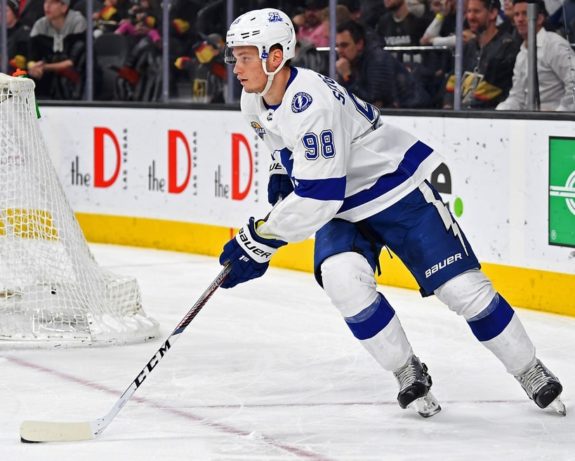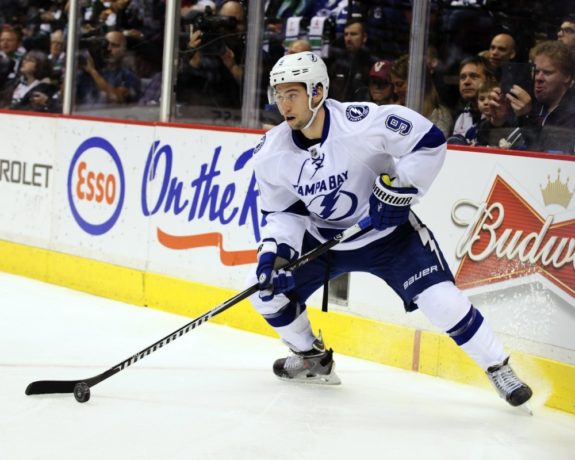![]()
For the Tampa Bay Lightning, the 2018-19 season has been a tale of two offenses. The first couple of games provided a painful flashback to last year’s Eastern Conference Final, where a potent offense suddenly couldn’t find the back of the net. That resulted in two consecutive shutouts, the latter of which was the final blow in losing a 3-2 series lead and the chance to play for Lord Stanley’s Cup.
In contrast, eight of the past nine games have featured an offense eerily similar to the one that scored its way to the Atlantic Division title a season ago. This type of high scoring thrilled fans who enjoyed seeing wide open back-and-forth contests between highly skilled teams.
These are the games that build rivalries. More recently, it’s decided who earned the right to represent the Eastern Conference in the Stanley Cup Final. Take the Pittsburgh Penguins or Washington Capitals, for example. Those two teams have ridden high-powered offenses to Stanley Cup championships the past few years. Two of those three years they clashed with the Lightning along the way, providing edge-of-your-seat action to fans of both teams.
Early on this season, the Lightning’s offensive struggles were beginning to worry some. Players and coaches said all the right things, but fans couldn’t help but fear the worst. Questions began to arise regarding this team’s ability to score enough goals to hang with top teams in the league.

The biggest concern was the slow start exhibited by many players, notably the two most consistent scoring threats from a season ago in Steven Stamkos and Nikita Kucherov. Both struggled early, with zero regulation goals and a combined six shots on net. Kucherov did score the shootout winner in the season opener against the Florida Panthers, but in that sort of gimme situation, it’s almost expected.
What made the biggest difference in the Lightning overcoming a sluggish start offensively? Many aspects of their game were tweaked slightly, with the results helping to propel them forward.
Mikhail Sergachev Helps Power Play Click
After beginning the season with Ryan McDonagh manning the point on the second power-play unit, with little to no success, the coaching staff decided to give Mikhail Sergachev the lions’ share of minutes on the man advantage.
That minor tweak seemed to work, as a struggling power play exploded for four man-advantage tallies in an 8-2 romp of the Columbus Blue Jackets on Oct. 13. This helped lift the Lightning out of the NHL cellar when it came to power play production, as their 0-for-8 start was nothing to write home about.

Other minor adjustments included moving Brayden Point to the second unit, a place where he thrived a season ago. His 11 power play points, five of which were goals, contributed to his breakout sophomore year. Perhaps more importantly, it gave him the freedom to use his speed to set up prime scoring chances. Even if the initial shot didn’t go in, the opportunity for rebounds existed and the Lightning pounced.
Moving Alex Killorn back to the first unit gave opponents a different look. So much time is spent tracking Kucherov and Stamkos that it’s easy to forget the guy stationed in the center of it all. Even though he struggled there in 2017-18, tallying two goals and nine points, he didn’t get many opportunities to touch the puck. That was because the dynamic duo combined to produce 69 points on the man advantage.
So far this year, Killorn has one goal and two points on the power play. Those numbers could be higher if not for the hot start by the second unit. Point and Yanni Gourde each have four points when the Lightning are up a man, while Sergachev has three.
While the power play has found success reverting back to last season’s alignment, the offense at even strength got going thanks to Cooper rolling the dice on something that drove the Lightning when they reached the Cup Final in 2015.
Triplets Reunited Kickstarts Lightning Offense
Two games into a new season and the Lightning found their offensive output ranked near the bottom of the NHL. Stamkos and Kucherov weren’t producing and neither was a good chunk of their other players. That was evidenced by the fact they scored twice in six regulation periods and three times overall.
In an attempt to find a spark, Cooper decided to shake up his top six. He reunited Kucherov with Ondrej Palat and Tyler Johnson, a trio that made magic a few short years ago, moved J.T. Miller to the fourth line and had Point centering Stamkos and Gourde.

The results were impressive, with the Lightning scoring no less than three goals in six of their next seven games. They went 6-0-1 in that span, losing only an overtime thriller to the Minnesota Wild.
Unfortunately, an injury to Palat late in the Vegas game on Oct. 26 forced the lines to become shuffled again. Miller found himself back on the top line alongside Stamkos and Kucherov and the team struggled to score again, tallying one goal in two of three contests. That was sandwiched around another eight-goal outburst against the New Jersey Devils on the eve of Halloween.
Seven of Kucherov’s 12 points came on a line with Johnson and Palat. That’s more than half of his production so far this season. Four of Johnson’s five goals, meanwhile, came while centering Kucherov and Palat. That includes a hat trick against the vastly improved Carolina Hurricanes on Oct. 16.
Are these the only differences in a stagnant offense suddenly exploding? It’s doubtful, as the Lightning boast too much firepower up and down the lineup to stay silent forever. These tweaks have helped an offense go from averaging one goal per game to nearly three in the blink of an eye.
*All player statistics courtesy of the NHL.